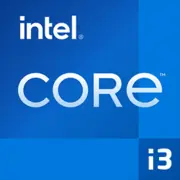Intel Core i3-10105

Intel Core i3-10105: Processore Economico per Attività di Base nel 2025
Aggiornato: aprile 2025
Caratteristiche Principali: Architettura e Prestazioni
Il processore Intel Core i3-10105, rilasciato nel 2021, continua a essere una scelta popolare per build economiche. Nonostante la sua età, le sue caratteristiche restano rilevanti per attività di base.
Architettura e processo produttivo
- Nome in codice: Comet Lake (10ª generazione Intel).
- Processo produttivo: 14 nm — tecnologia superata nel 2025, ma offre stabilità.
- Nuclei e thread: 4 nuclei, 8 thread grazie all'Hyper-Threading.
- Cache: 6 MB L3.
- Frequenza di base: 3.7 GHz, Turbo Boost fino a 4.4 GHz.
- Grafica integrata: Intel UHD Graphics 630 (frequenza di base 350 MHz, dinamica fino a 1.1 GHz).
Prestazioni
- Geekbench 6: 1489 (Single-Core), 4672 (Multi-Core).
- Attività reali: Nel 2025, il processore gestisce applicazioni da ufficio, browser (20+ schede), video 4K e giochi leggeri (ad esempio, CS:GO a impostazioni basse offre 60-80 FPS).
Caratteristiche principali
- Supporto per DDR4-2666.
- Efficienza energetica (TDP 65 W).
- Compatibilità con Windows 11 e Linux.
Schede madri Compatibili
Il processore utilizza il socket LGA 1200, il che limita la scelta delle schede madri a chipset più vecchi.
Chipset
- H410/B460: Opzioni economiche senza overclocking (prezzo: $60-80). Esempio: ASUS Prime H410M-K.
- H470/Z490: Funzionalità avanzate (PCIe 3.0, USB 3.2 Gen 2). Esempio: MSI Z490-A Pro ($120-150).
Consigli per la scelta
- Per l'i3-10105 è sufficiente una scheda madre H410/B460.
- Se si prevede un aggiornamento a i5/i7 di 10ª generazione — optare per Z490.
- Verificare il supporto M.2 NVMe (non presente in tutte le H410).
Memoria supportata
- Tipo: Solo DDR4 (fino a 2666 MHz). DDR5 non è supportato.
- Raccomandazioni:
- 16 GB (2x8 GB) — ottimale per il multitasking.
- Moduli economici (ad esempio, Kingston Fury Beast DDR4-2666, $35 per 16 GB).
Limitazioni: Frequenze superiori a 2666 MHz sono bloccate su chipset H410/B460.
Alimentatori: Calcolo e Raccomandazioni
Con un TDP di 65 W e l'assenza di una potente scheda grafica dedicata, è sufficiente un'alimentatore da 400-450 W.
Esempi:
- Per PC con scheda grafica di livello NVIDIA GTX 1650: Corsair CX450 (450 W, 80 Plus Bronze, $55).
- Senza grafica dedicata: EVGA 400 BR (400 W, $35).
Consiglio: Non risparmiare sull'alimentatore — modelli economici potrebbero avere prestazioni instabili con Turbo Boost.
Pro e Contro del processore
Pro:
- Prezzo: $100-120 (nuovo, 2025).
- Efficienza energetica (adatto per mini-PC).
- Grafica integrata per attività di base.
Contro:
- 14 nm contro 7-10 nm dei concorrenti.
- Nessun supporto per PCIe 4.0/5.0.
- Limitazione sulla frequenza della memoria.
Scenari d'uso
1. Ufficio e studio: Lavoro con documenti, Zoom, browser.
2. Multimedia: Visione di contenuti 4K, servizi di streaming.
3. Giochi leggeri: Dota 2, Minecraft, progetti indie.
4. Server domestico: Basso consumo energetico adatto per NAS.
Esempio: Build per $300:
- i3-10105 ($110) + H410 ($70) + 16 GB DDR4 ($35) + SSD 512 GB ($40) + alimentatore 450 W ($55).
Confronto con i concorrenti
1. AMD Ryzen 3 3300X (4 nuclei/8 thread, 7 nm):
- Migliore in compiti multithread (Geekbench Multi-Core ~5200).
- Prezzo: $130-150 (difficile trovarlo nuovo nel 2025).
2. Intel Core i5-10400 (6 nuclei/12 thread):
- Più potente del 30-40%, ma più costoso ($160-180).
Conclusione: l’i3-10105 vince in prezzo, ma perde in prestazioni.
Consigli Pratici per la Build
1. Raffreddamento: Il dissipatore stock è sufficiente (temperatura sotto carico fino a 70°C).
2. Storage: Scegliere SSD NVMe (ad esempio, Kingston NV1 500 GB, $40).
3. Aggiornamento: Pianificare in anticipo un eventuale passaggio a i5-10400 o i7-10700.
4. Case: Un Mini-Tower compatto è adatto (Deepcool MATREXX 30, $45).
Conclusione: A Chi Si Adatta il Core i3-10105?
Questo processore è una scelta ideale per:
- PC economici: Se l'obiettivo è costruire un sistema sotto i $400.
- Postazioni di lavoro da ufficio: Affidabilità e basso consumo energetico.
- Media center domestici: Streaming video, attività leggere.
Perché non prenderlo?
Per giochi con progetti AAA, montaggio 4K o lavoro con intelligenza artificiale è meglio considerare Ryzen 5 7600 o Core i5-12400F.
Verdetto finale: Il Core i3-10105 nel 2025 è un'opzione collaudata per chi cerca un equilibrio tra prezzo e prestazioni di base.
Di base
Specifiche della CPU
Specifiche della memoria
Specifiche della GPU
Varie
Classifiche
Rispetto ad altre CPU
Condividi sui social media
Oppure linkaci
<a href="https://cputronic.com/it/cpu/intel-core-i3-10105" target="_blank">Intel Core i3-10105</a>